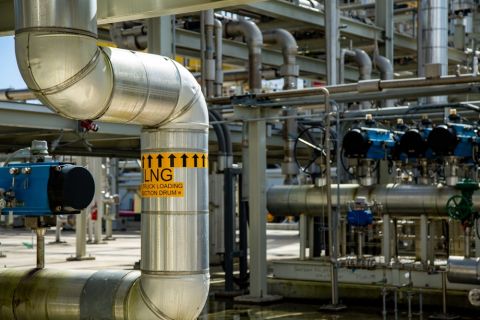A growing interest in liquids-rich unconventional reservoirs in North America has oil-prone explorers increasingly fixated on an emerging horizontal play in the Rocky Mountain region.
Already a proven conventional oil bearer, the Niobrara’s novelty lies is in its shale resource potential.
The Niobrara formation has flowed oil since the late 1800s, having established production from one of its sourced shales in Florence-Cañon City, the nation’s second oldest oil field, in Colorado. And, gas – biogenic in nature – was encountered in the shallower Niobrara formation in the early 1900s with the discovery of the Beecher Island field, also in Colorado.
The Niobrara remains a relatively unproven shale resource play in terms of its size and unconventional oil potential.
What is known is that its location, thermal maturity, rich source beds, and the presence of favorable reservoir facies all make for an attractive unconventional resource. This has been evidenced by a flurry of M&A deals in the region targeting the Niobrara and notably the recent US $570 million joint venture between Chesapeake Energy Corp. and China’s CNOOC Ltd. An uptick in leasing activity also has been duly noted by the Nebraska Bureau of Educational Lands & Funds. The board’s last two auctions in 2010 collected $3.2 million for 133,000 acres, with each sale trumping previous records.
Niobrara history, potential
The Niobrara Petroleum System, Upper Cretaceous in age, occurs across the Western Interior Cretaceous (WIC) basin, where natural fracturing can be extensive due to the ancestral Rocky Mountain area’s tectonic record. Deposited more than 80 million years ago, the self-sourced resource play is rooted in the midcontinent states of Wyoming, Colorado, Nebraska, and Kansas. Active exploration areas prospective for the shale include the Denver-Julesburg (D-J), Powder River, North Park, Greater Green River, Piceance, and Raton basins.
Characteristics include widespread mature source and reservoir rocks, strata ranging from around 30 m to more than 300 m (100 ft to more than 1,000 ft) in thickness; total organic carbon (TOC) values averaging around 3% and increasing to 5% or more; an abundance of carbonates, including organically rich limestones (chalks) and interbedded calcareous shales; and variable thermal maturity and reservoir conditions that can yield oil, gas, or both.
Analyzed using the Rock-Eval instrument, the Niobrara’s source rocks predominantly contain Type II (oil-prone) kerogen, according to the Colorado School of Mines Department of Geology & Geological Engineering. The richest of these can be found in the D-J basin, where hydrocarbon generation started in the Late Cretaceous. Here, TOC content reaches 8%.
E&P has focused on tapping what the US Geological Survey has indicated are significant hydrocarbons within the tight resource play.
Play potential
Unlike its huge cousin the Bakken to the northeast, the jury is still very much out on the Niobrara in terms of its potential profitability. A recent special report from IHS Energy compares the Niobrara to the Bakken, and study author Sven Del Pozzo reminds investors “how preliminary any analysis of the play is due to the limited number of wells and their short production histories.
“The Niobrara is situated at various depths and has diverse rock properties as it spans multiple basins, making it very risky to generalize about its prospectivity at this early stage,” he wrote.
Manny Nikhanj, vice president of Ross Smith Energy Group, told Hart Energy that the Niobrara is more complex than the Bakken, underpressured rather than overpressured, and has matrix rather than natural fracture permeability. This makes controlling costs a major risk factor in developing the play.
Ramona Hovey, senior vice president of analysis and consulting for DrillingInfo Inc., recently gave a presentation on Niobrara at Hart Energy’s Developing Unconventional Oil (DUO) conference in Denver. She said that it’s difficult to give an overview of the play because the information is still new.
“We’re just now getting a few of the early results out,” she said. “We’ve had about 15 wells with sufficient monthly production that came off confidential status in May.”
She added that early wells like Noble’s Gemini are targeting the B Sand in the play. “It’s a new thing for us to be able to start tackling what is being targeted in the Niobrara and what types of well tests are taking place.”
She added that early results indicate some very good wells that have very steep decline curves. Still, wells like EOG’s Jake well have made 102,000 bbl in a little more than a year.
“I wish we had a little more information compared to what we have in other plays,” she said. “It’s even more important because the geology is so different.”
How does it compare to the Bakken? Hovey said the Niobrara overall is thicker and at a shallower depth. The Bakken is more of a true oil play, whereas the Niobrara is a mixture of oil and gas. “Depending on where you are within the play and even within the Wattenberg field, it’s a real transition from oilier to dryer,” she said.
Hovey added that the leasing rush in Niobrara started in early 2010. It was scattered at first but began to focus in on the southern part of the Powder River and on the west side of the D-J Basin. More recently operators have begun moving into Lincoln and Elbert counties in Colorado.
Are operators disappointed in their results? “They got their plays and positions, particularly in the D-J Basin,” Hovey said. “There’s definitely less activity now. But then they’ll move to the manufacturing process and learn how to tweak that to get the most efficiency out of it.”
She added that by the end of 2011 her company should have considerably more data to analyze. “There’s still a lot of opportunity here,” she said. “We’re eager to see some results.”

Niobrara Shale
Players
Operators may not be sharing much information, but they are certainly staying active. In a June 2011 investor presentation, EOG Resources announced that it would continue to exploit its Hereford Ranch field, which currently produces about 4 MMbbl/d net. It also has a three-rig program under way concentrated on 80,000 of its approximately 220,000 net acres. It plans to drill 40 wells in 2011.
EOG also is starting to explore on other portions of its acreage and announced some recent well tests, including Fox Creek 3-35H at 552 bbl/d, Jersey 12-15H at 404 bbl/d, and Bessie 9-11H at 432 bbl/d, all at managed restricted rates.
In its 2010 annual report presentation, EOG commented, “Drilling results from Weld County, Colo., have increased EOG’s confidence in the economic viability of the D-J Basin Niobrara crude oil play. … Most importantly, EOG has made progress in establishing productivity from the Niobrara rock by successfully converting it from one dependent on fractures to a more matrix-dominated play. This increases the likelihood that the Niobrara is another true crude oil resource play that can be developed with tighter spacing and a greater number of economic wells than originally estimated.”
Peter Dea, CEO and founder of Cirque Resources, said his company is active in the play as well as other plays in the western US. He told the Denver Business Journal that his company gives the Niobrara play more than a 50% chance of success, when most of these types of plays get a 10 to 15% chance of success. “If the Niobrara horizontal drilling play pans out like some of us hope it does, it could be a significant economic boost to the county and the state with all of the related jobs,” he said.
Cirque owns mineral leases totaling 250,000 acres in the Niobrara.
Noble Energy is also bullish on the play. The largest leaseholder in the Niobrara, its horizontal drilling results have resulted in Jake, the best well ever drilled in Wattenberg. The company plans to shoot additional 3-D seismic and drill about 70 horizontal Niobrara wells in 2011, focused on accelerated development in the Wattenberg field and testing exploration opportunities in northern Colorado and southern Wyoming.
Carrizo Oil and Gas Inc. COO Brad Fisher spoke at DUO and characterized the Niobrara as easy to drill, offering the potential for long laterals similar to those in the Bakken. “But the completion side is really the big area we are trying to figure out,” he said.
Carrizo acquired 62,000 acres in the play in 2010 concentrated in Weld County. It continues to pursue acreage, although Fisher said that most of the high-quality acreage has already been leased. So far Carrizo has drilled three wells and has a rig running on its fourth. After struggling on the first, it shot a 2-D seismic line down the well path, discovering a 36-m (120-ft) fault that would have not have been obvious any other way. It was able to stay in zone 96% of the time, drilled a 1,040-m (3,400-ft) lateral, and fractured it with 17 stages. The well tested at 725 bbl/d, and its first-month average was 375 bbl/d.
Fisher added that the play’s structural complexities will make 3-D surveys a necessity.

More directional and horizontal wells are expected as more is learned about the play. (Graph courtesy of www.drillinginfo.com)
Chesapeake Energy is taking a more measured approach. John Dill, director of corporate development and government relations for the Rockies area for Chesapeake, said that it was too early to characterize the play relative to other shale plays that the company is active in.
Chesapeake started leasing in 2007 as part of a strategy to be constantly on the lookout for new ventures in unconventional oil. “We’ve been leasing for the past three years, and we’ve just started doing some exploration,” he said.
The company’s interest was piqued by the expansion into oil production and the search for new unconventional plays. “When we enter a play, we usually try to do so in a fairly robust manner,” he said. The sheer size of the play is part of the challenge – it covers about 650,000 sq km (250,000 sq miles) from slightly north of Casper, Wyo., to somewhat south of Denver.
Currently the company has six rigs operating, four in Wyoming and two in Colorado. Dill said that the rigs are constantly on the move as Chesapeake attempts to determine the best places to drill. “I think that’s going to continue for some period of time,” he said, adding that the company has plans to steadily increase its rig count over the next three to four years. Currently rig availability has not been an issue, he said.
It will be awhile before the company has its head wrapped around the play. “Every day we’re learning more about the play as we do this exploratory activity, and we are certainly smarter today than we were six months ago,” he said. “We’ll be smarter six months from now than we are right now.
“It’s an ongoing process that has fits and starts and takes time.”
Recommended Reading
Baker Hughes Awarded Saudi Pipeline Technology Contract
2024-04-23 - Baker Hughes will supply centrifugal compressors for Saudi Arabia’s new pipeline system, which aims to increase gas distribution across the kingdom and reduce carbon emissions
Battalion in Compliance with NYSE American after 2023 Meeting
2024-02-13 - Previously, Battalion Oil was not in compliance with the NYSE after failing to hold an annual meeting of stockholders during the fiscal year ending Dec. 31.
JMR Services, A-Plus P&A to Merge Companies
2024-03-05 - The combined organization will operate under JMR Services and aims to become the largest pure-play plug and abandonment company in the nation.
New Fortress Energy Sells Two Power Plants to Puerto Rico
2024-03-18 - New Fortress Energy sold two power plants to the Puerto Rico Electric Power Authority to provide cleaner and lower cost energy to the island.
Tellurian Executive Chairman ‘Encouraged’ by Progress
2024-03-18 - Tellurian announced new personnel assignments as the company continues to recover from a turbulent 2023.





